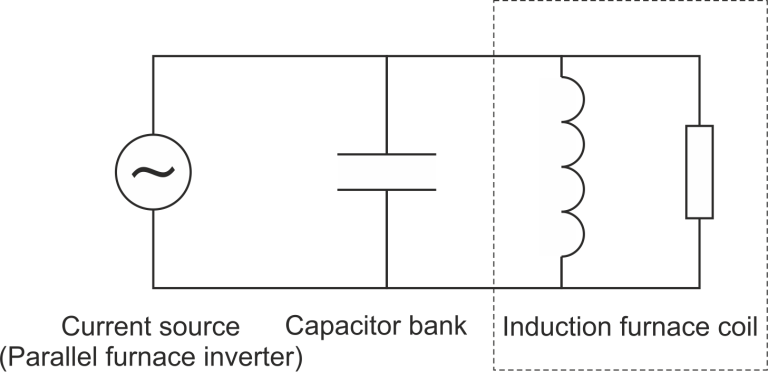Induction furnaces are categorized into two types based on the type of resonance circuit: series and parallel. (If you would like to learn more about the phenomenon of resonance, we recommend reading this article first.) In this article, we will examine the structural and functional differences between these two types of furnaces and review the advantages and disadvantages of each.
Series Induction Furnace
In a series induction furnace, the coil and capacitor bank are connected in series with the inverter output.
This configuration forms a series resonance circuit that transfers maximum power to the load at a specific frequency (the resonance frequency).
In this type of furnace, the output voltage from the rectifier feeds into a DC capacitor bank, which directly supplies the inverter.
One characteristic of this design is that the entire coil current—which can reach several thousand amperes—is supplied through the frequency converter panel. As a result, a high-power series furnace inverter contains a large number of thyristors arranged in series and parallel to handle the high voltage and current.
Another important point in series furnaces is the absence of a large DC choke in the inverter supply path. Therefore, in the event of a short circuit at the inverter output, the lack of a current-limiting element causes the short-circuit shock to be transferred directly to the grid and power transformer.
On the other hand, series furnaces have a major advantage: they offer a wide power control range, allowing the furnace power to be adjusted from 0 to 100% without generating reactive power.

Parallel Induction Furnace
In contrast, in a parallel induction furnace, the coil and capacitor bank are connected in parallel at the inverter output. To make the inverter output behave like a current source, a large DC choke is placed between the rectifier and the inverter to limit current fluctuations and deliver a relatively constant current to the inverter.
Since, in a parallel circuit, most of the current is exchanged between the coil and the capacitor bank, only a portion of the current is supplied through the frequency converter panel. This feature significantly reduces the panel size, the number of thyristors, and the required busbar size in parallel furnaces compared to series furnaces with similar power ratings.
In the event of a short circuit at the output, the presence of the DC choke in parallel furnaces greatly limits the shock transmitted to the power transformer and the grid—much more effectively than in series furnaces.
On the other hand, power control in parallel furnaces is somewhat more complex than in series furnaces. Especially under light loads or when operating at a small fraction of the furnace’s nominal power, reactive power may be generated, leading to a reduced input power factor.
To address this challenge, Sepahan Elgha has developed its own proprietary intelligent power control system. In this system, both the rectifier and inverter participate simultaneously in the power control process. This dual-control approach enables precise power adjustment without injecting reactive power into the grid. As a result, the induction furnaces manufactured by this company not only benefit from the advantages of parallel furnaces but also offer reactive power–free power control.


